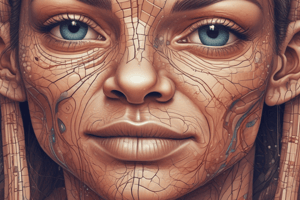Podcast
Questions and Answers
What are the three distinctive layers that form the skin?
What are the three distinctive layers that form the skin?
The epidermis, the dermis, and the hypodermis (subcutaneous layer)
What specialized cells are found in the epidermis, and what are their functions?
What specialized cells are found in the epidermis, and what are their functions?
Langerhans cells are macrophages that phagocytize infectious agents and then travel to lymphatic organs. Melanocytes produce melanin pigment responsible for skin color.
What is the outermost layer of the epidermis composed of?
What is the outermost layer of the epidermis composed of?
The outermost layer of the epidermis is composed of flattened, dead cells known as the stratum corneum.
In which layer of the epidermis do cells begin to die, and what is it named for?
In which layer of the epidermis do cells begin to die, and what is it named for?
What type of tissue is the dermis composed of?
What type of tissue is the dermis composed of?
What is the function of carotene pigment in the epidermis and dermis?
What is the function of carotene pigment in the epidermis and dermis?
What is the function of the sebaceous gland?
What is the function of the sebaceous gland?
Where are the free nerve endings located?
Where are the free nerve endings located?
What is the primary function of the skin?
What is the primary function of the skin?
Where are Meissner's corpuscles located?
Where are Meissner's corpuscles located?
What is the composition of sweat produced by the sweat gland?
What is the composition of sweat produced by the sweat gland?
What is the function of the arrector pili muscle?
What is the function of the arrector pili muscle?
What is the role of Pacinian corpuscles?
What is the role of Pacinian corpuscles?
What are the components of sebum secreted by the sebaceous gland?
What are the components of sebum secreted by the sebaceous gland?
What is the function of the apocrine sweat glands?
What is the function of the apocrine sweat glands?
Where are the blood vessels that supply nutrition to the skin located?
Where are the blood vessels that supply nutrition to the skin located?
Which layer of the skin is responsible for producing the melanin pigment?
Which layer of the skin is responsible for producing the melanin pigment?
What type of tissue forms the outermost layer of the epidermis?
What type of tissue forms the outermost layer of the epidermis?
Which layer of the skin contains carotene pigment responsible for giving a yellowish tone to the skin?
Which layer of the skin contains carotene pigment responsible for giving a yellowish tone to the skin?
What is the primary function of Langerhans cells in the skin?
What is the primary function of Langerhans cells in the skin?
Flashcards
Skin layers
Skin layers
The skin is made up of three layers: epidermis, dermis, and hypodermis.
Epidermis cells
Epidermis cells
Langerhans cells (phagocytes) and melanocytes (produce melanin) are found here.
Stratum corneum
Stratum corneum
Outermost layer of epidermis, dead cells.
Stratum granulosum
Stratum granulosum
Signup and view all the flashcards
Dermis tissue
Dermis tissue
Signup and view all the flashcards
Carotene function
Carotene function
Signup and view all the flashcards
Sebaceous gland function
Sebaceous gland function
Signup and view all the flashcards
Free nerve endings
Free nerve endings
Signup and view all the flashcards
Skin's main function
Skin's main function
Signup and view all the flashcards
Meissner's corpuscles
Meissner's corpuscles
Signup and view all the flashcards
Sweat composition
Sweat composition
Signup and view all the flashcards
Arrector pili muscle
Arrector pili muscle
Signup and view all the flashcards
Pacinian corpuscles
Pacinian corpuscles
Signup and view all the flashcards
Sebum composition
Sebum composition
Signup and view all the flashcards
Apocrine sweat glands
Apocrine sweat glands
Signup and view all the flashcards
Skin blood vessels
Skin blood vessels
Signup and view all the flashcards
Melanin production layer
Melanin production layer
Signup and view all the flashcards
Epidermis tissue
Epidermis tissue
Signup and view all the flashcards
Carotene layer
Carotene layer
Signup and view all the flashcards
Langerhans cell function
Langerhans cell function
Signup and view all the flashcards




